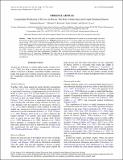Files in this item
Longitudinal prediction of divorce in Russia : the role of individual and couple drinking patterns
Item metadata
| dc.contributor.author | Keenan, Katherine | |
| dc.contributor.author | Kenward, Michael G. | |
| dc.contributor.author | Grundy, Emily | |
| dc.contributor.author | Leon, David A. | |
| dc.date.accessioned | 2017-08-01T10:30:10Z | |
| dc.date.available | 2017-08-01T10:30:10Z | |
| dc.date.issued | 2013-11 | |
| dc.identifier | 250544739 | |
| dc.identifier | 07b04deb-8af9-4ed3-bc3d-efae329b82c5 | |
| dc.identifier | 84886298645 | |
| dc.identifier.citation | Keenan , K , Kenward , M G , Grundy , E & Leon , D A 2013 , ' Longitudinal prediction of divorce in Russia : the role of individual and couple drinking patterns ' , Alcohol and Alcoholism , vol. 48 , no. 6 , pp. 737-742 . https://doi.org/10.1093/alcalc/agt068 | en |
| dc.identifier.issn | 1464-3502 | |
| dc.identifier.other | RIS: 4 | |
| dc.identifier.other | ORCID: /0000-0002-9670-1607/work/35292663 | |
| dc.identifier.uri | https://hdl.handle.net/10023/11336 | |
| dc.description | At the time of the research, K.K. was funded by an Economic and Social Research Council PhD studentship. Funding to pay the Open Access publication charges for this article was provided by Research Councils UK (RCUK). | en |
| dc.description.abstract | Aims : The aim of the study was to explore associations between dimensions of alcohol use in married couples and subsequent divorce in Russia using longitudinal data. Methods : Follow-up data on 7157 married couples were extracted from 14 consecutive annual rounds (1994–2010) of the Russian Longitudinal Monitoring Survey, a national population-based panel study. Discrete-time hazard models were fitted to estimate the probability of divorce among married couples by drinking patterns reported in the previous survey wave. Results : In adjusted models, increased odds of divorce were associated with greater frequency of husband and wife drinking (test for trend P = 0.005, and P = 0.05, respectively), wife's binge drinking (P = 0.05) and husband's heavy vodka drinking (P = 0.005). Couples in whom the wife drank more frequently than the husband were more likely to divorce (OR 2.86, 95% CI 1.52–5.36), compared with other combinations of drinking. The association between drinking and divorce was stronger in regions outside Moscow or St. Petersburg. Conclusion : This study adds to the sparse literature on the topic and suggests that in Russia heavy and frequent drinking of both husbands and wives put couples at greater risk of future divorce, with some variation by region and aspect of alcohol use. | |
| dc.format.extent | 6 | |
| dc.format.extent | 83869 | |
| dc.language.iso | eng | |
| dc.relation.ispartof | Alcohol and Alcoholism | en |
| dc.subject | Alochol drinking | en |
| dc.subject | Russia | en |
| dc.subject | Divorce | en |
| dc.subject | H Social Sciences (General) | en |
| dc.subject | RA0421 Public health. Hygiene. Preventive Medicine | en |
| dc.subject | SDG 3 - Good Health and Well-being | en |
| dc.subject.lcc | H1 | en |
| dc.subject.lcc | RA0421 | en |
| dc.title | Longitudinal prediction of divorce in Russia : the role of individual and couple drinking patterns | en |
| dc.type | Journal article | en |
| dc.contributor.institution | University of St Andrews. Geography & Sustainable Development | en |
| dc.identifier.doi | 10.1093/alcalc/agt068 | |
| dc.description.status | Peer reviewed | en |
This item appears in the following Collection(s)
Items in the St Andrews Research Repository are protected by copyright, with all rights reserved, unless otherwise indicated.

